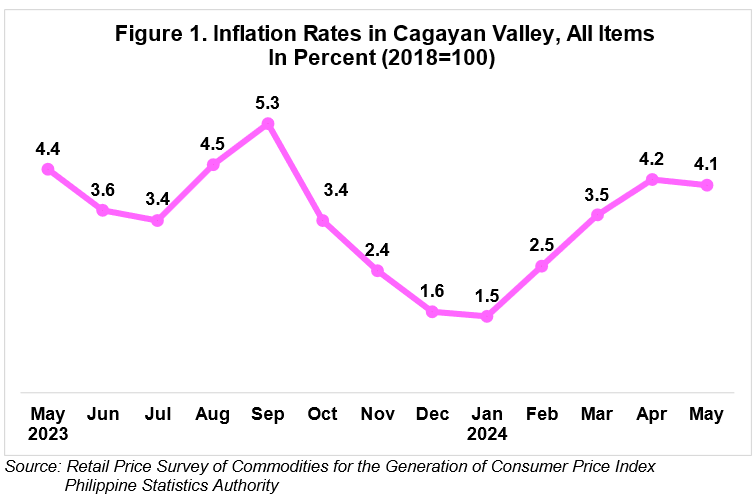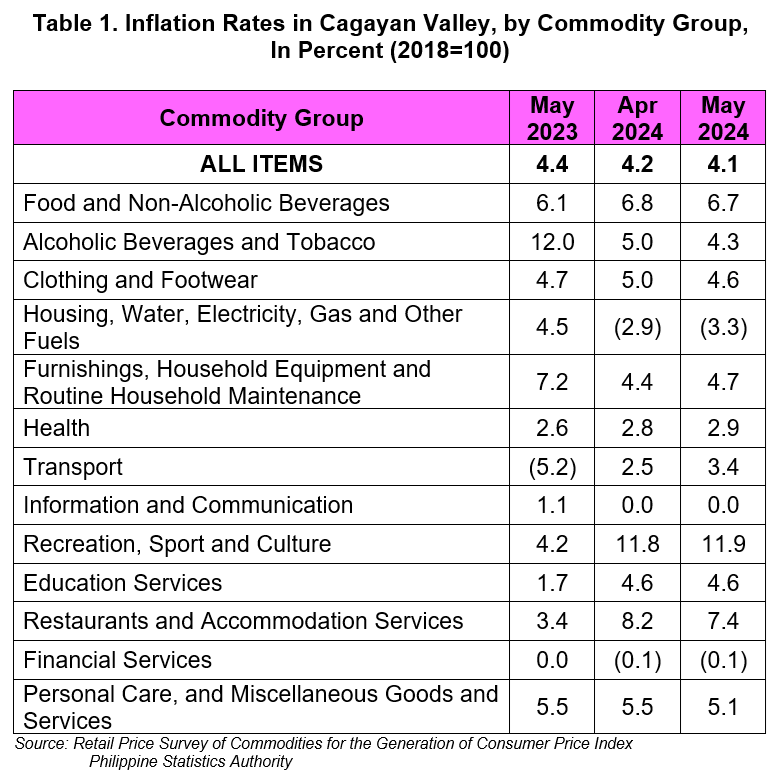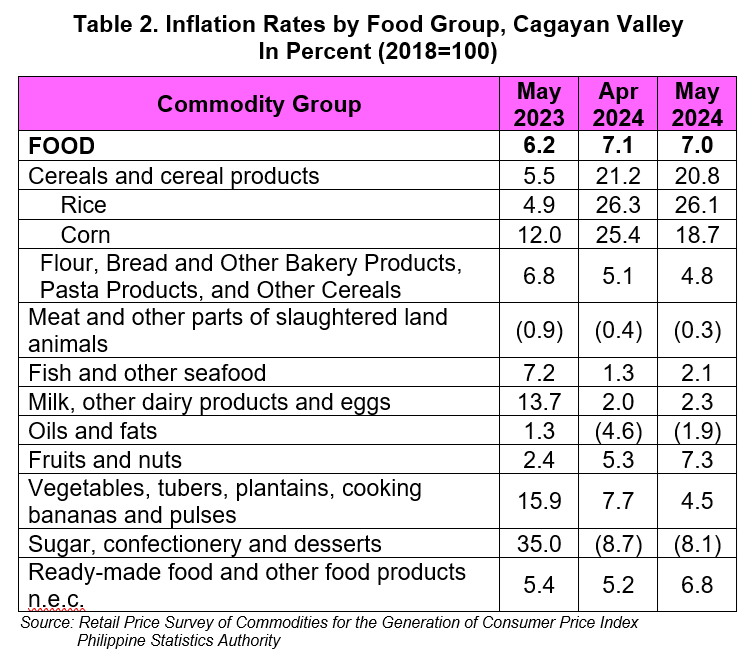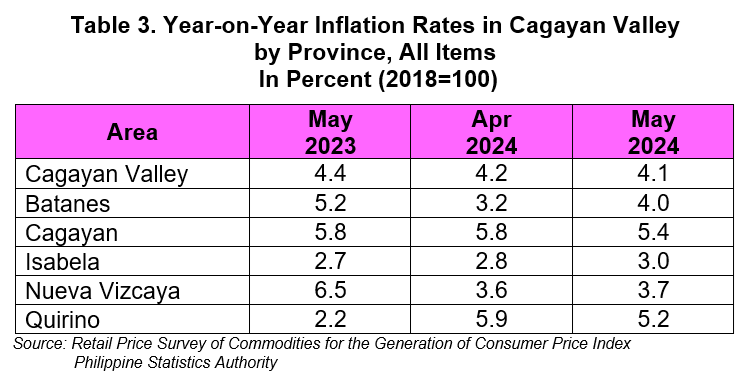The overall inflation rate of Cagayan Valley decreased to 4.1 percent in May 2024, showing a slight drop compared to the previous months' upward trend. This resulted to a 3.2 percent regional average inflation rate from January to May of 2024. In May 2023, the inflation rate was higher at 4.4 percent. (Figure 1)

The decline in the overall inflation of Cagayan Valley in May 2024 was primarily influenced by the lower year-on-year rate of Housing, water, electricity, gas and other fuels which recorded -3.3 percent during the month from -2.9 percent in April 2024. The drop of Restaurants and accommodation services index at 7.4 percent in May 2024 from 8.2 percent in the previous month also contributed to the downtrend.
In addition, decrements were also noted in the indices of the following commodity groups during the month:
• Food and non-alcoholic beverages, 6.7 percent from 6.8 percent;
• Personal care, and miscellaneous goods and services, 5.1 percent from 5.5 percent;
• Alcoholic beverages and tobacco, 4.3 percent from 5.0 percent;
• Clothing and footwear, 4.6 percent from 5.0 percent;
In contrast, the indices of the following commodity groups showed higher year-on-year growth rates for May 2024:
• Furnishings, household equipment and routine household maintenance, 4.7 percent from 4.4 percent;
• Health, 2.9 percent from 2.8 percent;
• Transport, 3.4 percent from 2.5 percent; and
• Recreation, sport and culture, 11.9 percent from 11.8 percent.
The indices of the rest of the commodity groups retained their respective previous month’s inflation rates. (Table 1)

Food inflation in Cagayan Valley also decreased to 7.0 percent in May 2024 from 7.1 percent in April 2024. May 2023, food inflation was lower at 6.2 percent.
The deceleration of food inflation in May 2024 was mainly brought about by the lower inflation in Vegetables, tubers, plantains, cooking bananas and pulses at 4.5 percent during the month from 7.7 percent in April 2024. This was followed by Rice with inflation rate of 26.1 percent from 26.3 percent; Corn with 18.7 percent from 25.4 percent; and Flour, bread and other bakery products, pasta products, and other cereals with 4.8 percent from 5.1 percent.
Conversely, compared with their previous month’s inflation rates, higher inflation rates were observed in the indices of the following food items:
• Meat and other parts of slaughtered land animals, -0.3 percent from -0.4 percent;
• Fish and other seafood, 2.1 percent from 1.3 percent;
• Milk, other dairy products and eggs, 2.3 percent from 2.0 percent;
• Oils and fats, -1.9 percent from -4.6 percent;
• Fruits and nuts, 7.3 percent from 5.3 percent;
• Sugar, confectionery and desserts, -8.1 percent from -8.7 percent; and
• Ready-made food and other food products n.e.c., 6.8 percent from 5.2 percent. (Table 2)

Two provinces showed a downtrend in their inflation rates, Cagayan province, with the highest rate at 5.4 percent among all provinces in the region, showed a decrease from 5.8 percent in April 2024. Furthermore, the inflation rate in Quirino province dropped to 5.2 percent in May 2024 from its 5.9 percent recorded in April 2024. Meanwhile, three provinces showed higher rates of inflation in May 2024 compared with the previous month’s record. Batanes increased from 3.2 percent to 4.0 percent. Despite an uptick from 2.8 percent to 3.0 percent, Isabela Province remained to have the lowest inflation rate in May 2024. Nueva Vizcaya also experienced a slight increase from 3.6 percent to 3.7 percent. (Table 3)

The Province of Cagayan have the highest percent share to the lower inflation rate of the region with 78.5 percent. The lower inflation rate of the province was observed in the indices of the following commodity groups:
• Housing, water, electricity, gas and other fuels, -0.5 percent from 1.2 percent;
• Restaurants and accommodation services, 13.1 percent from 16.2 percent;
• Personal care, and miscellaneous goods and services, 8.2 percent from 9.0 percent;
• Alcoholic beverages and tobacco, 6.2 percent from 7.4 percent; and
• Clothing and footwear, 7.4 percent from 8.4 percent.
The rest of the commodity groups in the province either remained at their previous month’s rates or had higher growth rates.
Note: CPIs and inflation rates by province and selected city are posted at the PSA OpenSTAT Portal at (https://openstat.psa.gov.ph/).
ENGR. GIRME M. BAYUCAN
(Chief Statistical Specialist)
Officer-in-Charge, PSA RSSO II
//EMDP/JCB/MLLP/SJCP
